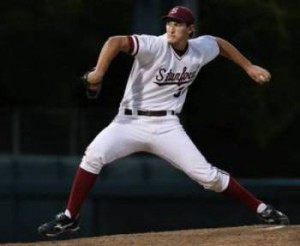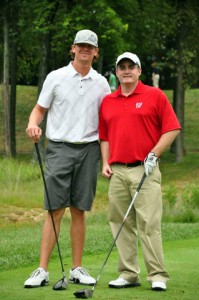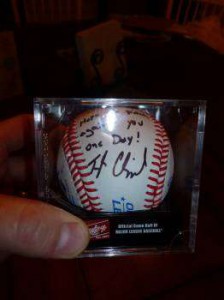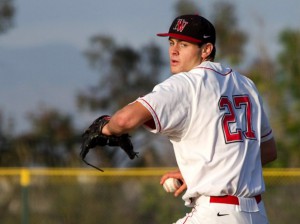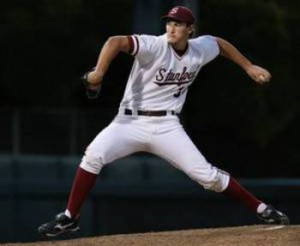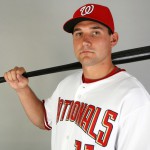
Face of the Franchise Zimmerman easily represents the best player drafted in the Washington era (by WAR). Photo team official
This is the Third in a long-delayed series of “Best of” posts, breaking down the transactions of both the club’s General Managers. Previously:
1. Biggest/Best/Worst Trades in Nats History (March 2012)
2. Biggest/Best/Worst Free Agent signings in Nats History (November 2012).
Here’s Part 3: looking at the Biggest, Best and Worst Draft picks the team has made since arriving here in Washington.
Ground rules for this article:
1. Unlike the trades and free agent posts, assiging “credit” or “blame” for draft picks on the General Manager is not entirely straightforward. Baseball teams rely heavily on Scouting Directors and their staffs when it comes to the draft, especially once you get past the first few rounds. So, perhaps for the purposes of this article it is better to talk about the “Reign of Jim Bowden” and the “Reign of Mike Rizzo” instead of insinuating that every draft decision was made by the GM during these times. Much like the President of the US gets credit/blame when the US economy as a whole rises or falls (whether or not you’d like to argue that a president’s decisions can influence a multi-trillion dollar economy), so does the GM get the credit/blame for his staff’s draft picks. Most baseball pundits that I’ve read generally say that the GM/Team Ownership is always directly involved in making any 1st round and supplemental first round picks (because of the money), and will be involved if over-slot bonuses come up in later rounds, but that by the 5th round or so the entire draft is being conducted without the GM’s involvement. Which leads us to point #2…
2. Related to #1; Mike Rizzo, whom Bowden hired in July of 2006, may not have been the Scouting Director but he certainly had a say in the drafts (coming from a scouting background in Arizona). I’ll list scouting directors tenure here as well, related to #1 and #2. But, it probably isn’t going to be entirely fair to the GM to say that such-and-such a pick was “good” or “bad” if it was actually being done by his staff.
3. It is entirely “hindsight is 20/20” in nature. But, it is what it is. If you draft a 1st rounder who flames out in low-A, he’s a failure. If you draft a major leaguer in the 21st round, he’s a fantastic success. Mostly here in judging the “best draft picks” I’m looking for value in later rounds. As it turns out judging “worst” draft picks mostly will be around first round busts.
Just for review, here’s the tenure period of both GMs:
- Nov 2004 – Mar 2009: Jim Bowden
- Mar 2009 – present: Mike Rizzo
And here’s the tenure period of Scouting Directors during our time here in Washington:
- Mid 2002 – Mar 2009: Dana Brown
- Mar 2009 – Present: Kris Kline
The quintessential Nats Draft resource is the Draft Tracker Spreadsheet, initially created by NatsFarm.com’s Brian Oliver and now maintained by “SpringfieldFan. ” It has all our draft picks, where they came from and signing bonuses. A file I’ve kept recently (The Draft Prospects Worksheet) is a file I started to create when the Nats started getting some upper-end draft picks as a way to track who we may take. Lastly, you can query the entire amateur draft results per team at baseball-reference.com (the link will go to the 2009 draft by way of example).
Jim Bowden Tenure: Nov 2004 – Mar 2009
Bowden’s Biggest Draft Picks (in terms of dollars committed).
- 2005 1st rnd: Ryan Zimmerman, $2.975M
- 2007 1st rnd: Ross Detwiler, $2.1M
- 2007 6th rnd: Jack McGeary: $1.8M
- 2006 1st rnd: Chris Marrero: $1.6M
- 2006 1st rnd: Colten Willems: $1.4M
Bowden’s Best Draft Picks
- 2005 11th rnd: John Lannan out of Siena College. A durable and servicable lefty starter with MLB average numbers out of a small college in the 11th round is a great find.
- 2005 12th rnd: Craig Stammen out of Dayton. He didn’t look as if he’d be successful until his transition to the bullpen, where his arm action and movement have baffled hitters during his shorter reliever stints.
- 2006 41st rnd: Brad Peacock out of a Florida HS as a “draft and follow” guy (which enabled teams to take late round fliers on good talent, so this isn’t exactly the same as finding a true 41st round player who made the majors, since Peacock likely wouldn’t have been taken without the DDE rules in place and would have been an upper round draft pick the next season he was eligible).
- 2007 2nd rnd: Jordan Zimmermann out of U Wisconsin Stevens Point (not because of his draft position, but because of the scouting out of such a small school). Zimmermann survived TJ surgery and now looks like a hidden Ace in the making.
- 2007 4th rnd: Derek Norris out of a Kansas HS: possibly the best HS player the team has drafted since arriving in DC.
- 2008 10th rnd: Tommy Milone out of USC. Rizzo may not have rated him, but he looks to be in Oakland’s rotation for many years to come.
- 2008 16th rnd: Tyler Moore out of Mississippi State. Scouts continually have downplayed Moore’s power; I have never read a scouting report on Moore that didn’t focus on “holes in his swing” or “defensive liabilities.” All he’s done is mash the ball at every level he’s been challenged with in his career.
- 2008 19th rnd: Steve Lombardozzi out of St. Petersburg JuCo. Despite his pedigree (his father played in the Majors in parts of 6 seasons), Lombardozzi was lightly pursued and surprisingly signed as a late round JuCo draftee. He’s scraped his way to the top though and could find himself starting if the team decides to move Espinosa.
Despite the issues at the top of the 2008 draft, it may have been Bowden’s best. He took no less than 6 guys who now are on 25-man rosters in this league (Milone, Moore, Lombardozzi, Espinosa, and Crow). 2005 wasn’t bad either, with 7 guys that have MLB appearances (though only 3 remain with the team).
Bowden’s Worst Draft Picks
- 2006: almost the entire draft. Bowden blew the first 6 picks on high schoolers, the best of whom was Chris Marrero, who has contributed -0.7 WAR in his career thus far. First round pick Colten Willems flamed out and just gave up playing in the middle of the 2010 season, Stephen Englund was released (but not before earning a 50-game suspension for Amphetemine usage), Sean Black didn’t sign and Stephen King has yet to succeed above A-ball despite being in his his 6th pro season (and, just for good measure, had his own 50-game drug suspension in 2009). Only one player in the top 12 rounds of picks even played a day in the majors. Just a complete debacle of a draft.
- 2007’s high schoolers: Smoker, Souza, Burgess, and Smolinkski: all top 3 round picks, all busts.
- 2007’s Jack McGeary, who insisted (admirably) on also going to college, but probably at the detriment of his baseball career. I’m sorry; if someone pays you $1.8M dollars in cash, you probably should work for that money. McGeary never was able to master anything above rookie ball and was so under-valued by the team that they failed to protect him in the minor league phase of the 2012 Rule 5 draft (where he was subsequently taken by Boston).
- The 2008 Aaron Crow debacle. Yes I know that this pick turned into 2009’s Drew Storen. And yes I know that Crow has now been turned into a middle reliever while Storen has turned into an effective closer. At the time, this move helped continue the “incompetent” labels that the organization was earning, as Bowden reportedly refused to negotiate with Crow’s agents and failed to do his due diligence before drafting the player. Who is to say whether Crow’s electric arm wouldn’t have turned into a regular rotation member in our organization (Kansas City doesn’t exactly have a stellar record of developing pitchers). In the end, getting Storen and also not losing the opportunity cost of missing a year’s development time of a first round pick (by virtue of the rest of the team being so awful) ended up not hurting the team. But it still goes down as a draft failure for Bowden.
Mike Rizzo Tenure: Mar 2009 – present
Rizzo’s Biggest Draft Picks (in terms of dollars committed).
- 2009 1st rnd: Stephen Strasburg: $7.5M bonus, 15.1M guaranteed
- 2010 1st rnd: Bryce Harper: $6.25M bonus, $9.9M guaranteed
- 2011 1st rnd: Anthony Rendon: $6M, $7.2M guaranteed
- 2011 3rd rnd: Matthew Purke: $2.75M bonus, $4.15M guaranteed
- 2011 1st rnd (supplemental): Brian Goodwin: $3M
- 2012 1st rnd: Lucas Giolito: $2.9M
- 2011 1st rnd: Alex Meyer: $2M
- 2010 4th rnd: A.J. Cole: $2M
- 2009 1st rnd: Drew Storen: $1.6M
As we saw with the Free Agent post, Rizzo clearly had more money to work with from Ownership than Bowden did. Spending $2M on a 4th round pick (AJ Cole) would have been unheard of in the Bowden reign.
Rizzo’s Best Draft Picks
- 2009 12th rnd: Nathan Karns out of Texas Tech: Karns got 4th/5th round money in the 12th round but has been bedeviled by injuries until this year. By now we know what he’s capable of; our organization’s Minor League pitcher of the Year earned a spot on the 40-man roster and could be in line for a 2013 late season call-up. It could be too-early to tell, but right now this is looking like one of Rizzo’s best.
- 2009 22nd rnd: Danny Rosenbaum out of Xavier; despite the team not protecting him and losing him in Rule-5, he had come out of no-where to be one of our best pitching prospects.
- 2010 12th rnd: Robbie Ray out of a Tennessee HS; he had a great debut and has been steadily rising up the ranks. The team was able to buy him out of a committment to the University of Arkansas by offering 2nd round money.
- 2010 22nd rnd: Cameron Selik as a U Kansas senior has made it to AA and looks like a great later-round steal, especially for a college senior this low in the draft.
- 2011 5th rnd: Matt Skole out of Georgia Tech looks like he could be an excellent hitting prospect and is making it into the top 5 lists of Nationals prospects.
- 2011 1st rnd supp: Brian Goodwin out of a Miami JuCo looks more advanced than anyone would have thought at this point, and could be pressing for playing time in 2013. I don’t normally give plaudits for 1st round talents, but the team aggressively pursued and captured Goodwin at a time when it looked like he was heading to UNC.
Rizzo’s Worst Draft Picks
- 2009 2nd rnd: Jeff Kobernus out of Cal Berkeley. Perhaps less because of his production (which was mostly poor for his career), but moreso because the decision not to protect him and value your investment in the player, leading to his departure in the 2012 rule-5 draft. No worries for Nats fans: Rizzo drafted almost the doppelganger of Kobernus in 2012: again taking a 2nd baseman from California in the second round (Tony Renda). Lets hope it works out better this time.
- 2009 3rd rnd: Trevor Holder out of Georgia. A blatant punt on the draft pick to save money, Holder was a college senior with zero leverage and should have been offered closer to $1,000 instead of the $200,000 he got. Holder has struggled for years in our system. He did have a decent 2nd half in Harrisburg, so there is hope yet. But 3rd round picks should have more promise than Holder has shown.
- 2010 3rd rnd: Rick Hague out of Rice. He hasn’t lived up to his 3rd round billing yet, though (to be fair) he has struggled with some injuries.
Rizzo’s Too Soon to Tell Draft Picks
- 2010 2nd rnd: Sammy Solis was looking promising out of U San Diego, but has been side lined by Tommy John Surgery.
- The 2011 college-arm gamble: Rizzo drafted dozens of college players this draft, stocking the system with experienced amateurs.
- 2012 1st: the Lucas Giolito gamble won’t play itself out for a couple of years, but it is safe to say Rizzo went “all in” on this player. A 1-1 talent but damaged goods upon drafting, the team is putting a lot of faith into its experience in dealing with hurlers going through Tommy John.
- 2011 3rd: Matt Purke got a MLB deal and a whole lot of money, and has done relatively nothing to earn it because of lingering shoulder injuries. I’m listing him as too early to tell, but the signs are not good.
